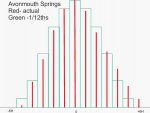Elessar
Well-Known Member
12ths works fine even in the solent on a rising tide.I found that the rule of 12th works very well in the Bristol channel because the tidal sine curve period is symmetrical; unlike the Solent where its unsymmetrical sine curve.
Still use doug748s KISS method the most though.

